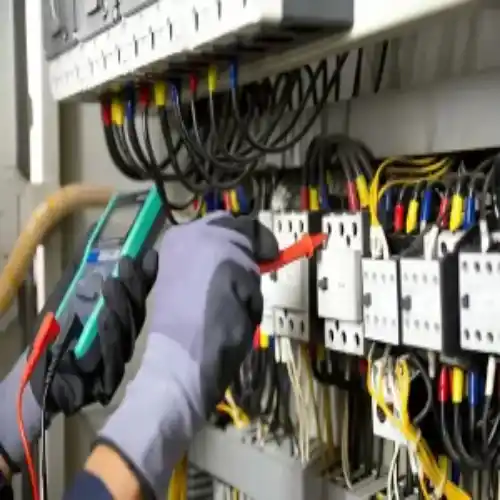An Electrical Protection System (EPS) is essential for ensuring the safety and reliability of electrical power systems. It detects faults and abnormal conditions, then isolates the affected portions to prevent damage to equipment and minimize disruption. Here’s an overview of the key components, functions, and types of protection systems used in electrical engineering:
Key Components of Electrical Protection Systems
- Relays: Devices that detect abnormal conditions in the electrical system (e.g., overcurrent, overvoltage) and send signals to circuit breakers to isolate the fault.
- Circuit Breakers: Automatically operated switches designed to protect electrical circuits from damage caused by overloads or short circuits by interrupting the flow of electricity.
- Current Transformers (CTs): Devices that measure the current in a circuit and provide a reduced current proportional to the measured current for relays and metering devices.
- Voltage Transformers (VTs) or Potential Transformers (PTs): Devices that measure the voltage in a circuit and provide a reduced voltage proportional to the measured voltage for relays and metering devices.
- Protection Relays: Include various types such as overcurrent relays, differential relays, distance relays, and more, each designed to detect specific types of faults.
- Communication Systems: Used for transmitting information between different parts of the protection system, especially in complex and distributed networks.
- Batteries and Power Supplies: Ensure that the protection system remains operational even during power outages.
Functions of Electrical Protection Systems
- Fault Detection: Identify faults in the system (e.g., short circuits, ground faults) quickly and accurately.
- Fault Isolation: Isolate the faulted section from the rest of the system to prevent damage and ensure safety.
- System Stability: Maintain the stability and continuity of the power system by minimizing the impact of faults.
- Equipment Protection: Protect electrical equipment like transformers, generators, motors, and transmission lines from damage.
- Safety: Ensure the safety of personnel by preventing electrical hazards.
Types of Protection Systems
- Overcurrent Protection
- Protects against excessive current that can cause overheating and damage.
- Types: Instantaneous, time-overcurrent, and inverse-time relays.
- Differential Protection
- Compares the current entering and leaving a protected zone (e.g., transformer, generator) and isolates it if a difference indicates a fault.
- Highly sensitive and accurate for internal faults.
- Distance Protection (Impedance Protection)
- Commonly used in transmission line protection.
- Under/Over Voltage Protection
- Protects equipment from operating outside safe voltage limits.
- Under/Over Frequency Protection
- Protects equipment from operating outside safe frequency limits.
- Ground Fault Protection
- Detects faults where current flows to ground, which can cause serious hazards.
- Directional Protection
- Determines the direction of fault current flow to identify the faulted section in complex network configurations.
- Breaker Failure Protection
- Detects if a circuit breaker fails to open during a fault and initiates backup protection to clear the fault.
Example Protection Scheme
Consider a typical high-voltage transmission line protection scheme:
- Primary Protection: Distance relays are used as primary protection because they can detect and isolate faults quickly by measuring impedance.
- Backup Protection: Overcurrent relays serve as backup protection in case the distance relays fail to operate.
- Breaker Failure Protection: If the circuit breaker associated with the primary relay fails to operate, breaker failure relays will initiate tripping of adjacent breakers to isolate the fault.
Advancements in Electrical Protection Systems
- Microprocessor-Based Relays: Offer enhanced accuracy, flexibility, and functionality compared to electromechanical relays.
- Digital Communication: IEC 61850 standard for communication networks and systems in substations enables interoperability and faster data exchange.
- Phasor Measurement Units (PMUs): Provide real-time monitoring and control by measuring the electrical waves (phasors) on an electricity grid.
Maintenance and Testing
Regular maintenance and testing of protection systems are crucial to ensure reliability and proper operation. This includes:
- Routine Inspections: Visual checks and physical inspections of equipment.
- Functional Testing: Testing the functionality of relays and breakers.
- Calibration: Ensuring that CTs, VTs, and relays are calibrated correctly.
- Simulation Testing: Simulating fault conditions to verify the correct operation of the protection system.
By incorporating these components and principles, an electrical protection system can effectively safeguard power systems, ensuring both operational efficiency and safety.
